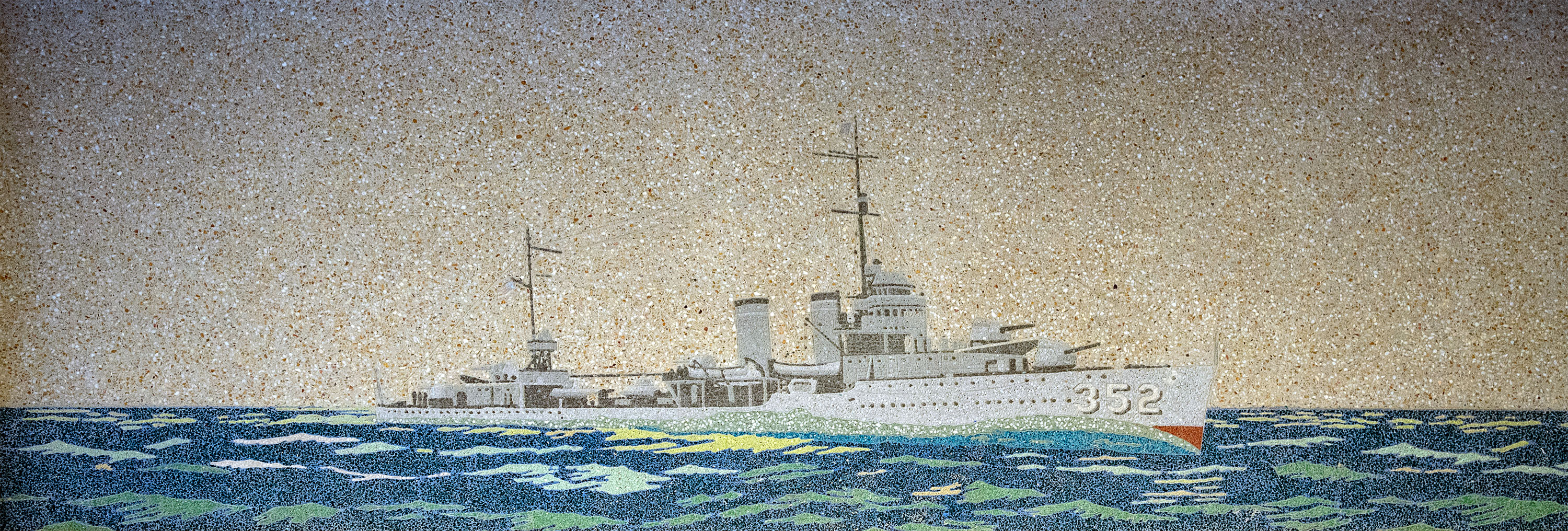
August 2003 excerpt, Wavelengths
USS Worden’s Bell Rings Again
Naval architecture center at Carderock dedicates memento
By William Palmer
WEST BETHESDA, Md. — On July 10, 2003, employees gathered in the Taylor Room to witness an acceptance ceremony during which a ship’s bell was installed in a specially constructed mount along the room’s east wall. The bell is the sole remaining artifact of USS Worden (DD 352), a Farragut Class destroyer sunk off the Aleutian Islands near Alaska in 1943.
[See the dedication event program here.]
The ship was the fifth of its class and the third vessel to bear the namesake of John L. Worden, who captained USS Monitor during her historic battle with CSS Virginia during the Civil War. The Worden’s bell is on long-term loan to the West Bethesda site from the Naval Historical Center (NHC), Washington, DC.

The ship demonstrated a number of dramatic hydrodynamic improvements which had been developed in the Experimental Model Basin, predecessor test facility of Carderock Division’s David Taylor Model Basin.
Commander Stephen Surko (002), Chief Staff Officer at the West Bethesda site, was instrumental in acquiring the bell and setting it in the Taylor Room on display. The impetus to acquire the bell took root last July. When the annual “Let Freedom Ring” celebration was announced, it struck Surko that, even though the West Bethesda site is a large naval installation, it had no bell with which to participate in the national event or use in military ceremonies. He started investigating how a bell could be acquired for the command, contacting Curator of Models Dana Wegner (301) and eventually calling the NHC. Surko found out NHC has numerous ship artifacts and had several bells available for loan. But there was a catch.
There needed to be a “connection” between West Bethesda and the ship’s bell. Unfortunately, the ship named for the Model Basin’s founder, USS David W. Taylor (DD 551), was transferred to Spain and later scrapped without its bell being saved. Surko then considered the mosaics, adorning the east and west walls of the Taylor Room, for a link. Six ships in all are represented in the Taylor Room, and Surko submitted their names to the NHC to see if there was a match. They did have a bell for one of the ships depicted, the Worden, the center of three ships portrayed in the east wall mosaics. This came as a surprise because the ship had been driven onto rocks during her support of the occupation of Amchitka Island, suffered a hull rupture, and sank. How did the bell survive the sinking?
Robert Cressman, historian, author, and head of NHC’s Ship History Branch, presented a detailed ship’s history to those gathered. He explained that the bell, weighing 110 pounds, was removed early in WWII to reduce topside weight — so the bell was no longer on Worden when it sank off the Aleutians. The bell later saw service aboard the fourth USS Worden (CG 18), and Cressman suggested that the damage evident on the bell was likely shrapnel from action seen by the ship during the Vietnam War.
Present at the dedication ceremony were Myron Scott, who was a Quartermaster 3rd class petty officer onboard the Worden at the time she sank. He was accompanied by his wife Ruth and their grandson Jason. The Worden Sailors were also represented by William Thomas (5500), William Thomas Jr., grandson and son, respectively, of William Thomas Sr., Chief Boatswain’s Mate on the Worden. Thomas Jr.’s wife Joyce Thomas and sister Mary Batten, a member of the Women Accepted for Volunteer Service (WAVES) during WWII, also attended, as well as Walt Baranger, an editor for the New York Times and son of Lieutenant Commander Walter Baranger, Radio Officer on the Worden.
During dedication ceremony comments, Surko said “I would suggest that the USS Worden bell is more than just a connection with the past, but also as a reminder of our connection with the Fleet for today and tomorrow. Sailors will continue go in harm’s way in the ships we help design and in the ship systems we develop and help maintain.”
Special thanks are extended to those who worked behind the scenes to bring the ceremony to fruition. Wegner pointed out the excellent support from William Ottinger (36124); Arthur Gehringer, James Stewart, and Ralph Huff (36125); and Thomas Reed and Alan Selwyn (36133), to construct and install the Worden’s bell and its mounting. “These fellows deserve special credit,” said Wegner, “for their ideas, ingenuity, and execution. It was a pleasure working with them. They were dedicated to the job and delivered on schedule.” The Tin Can Sailors Association provided invaluable assistance in contacting former Worden crew members.